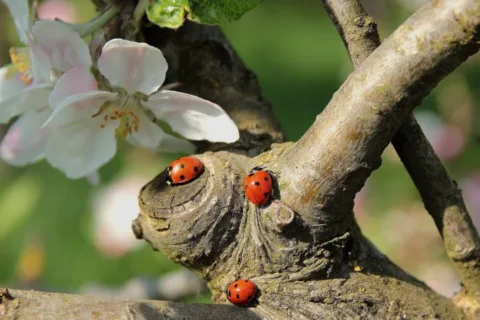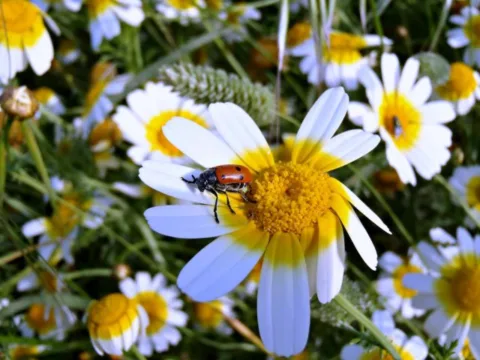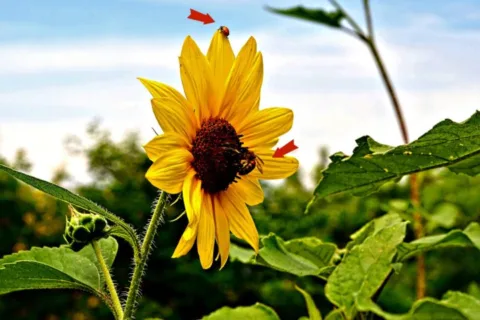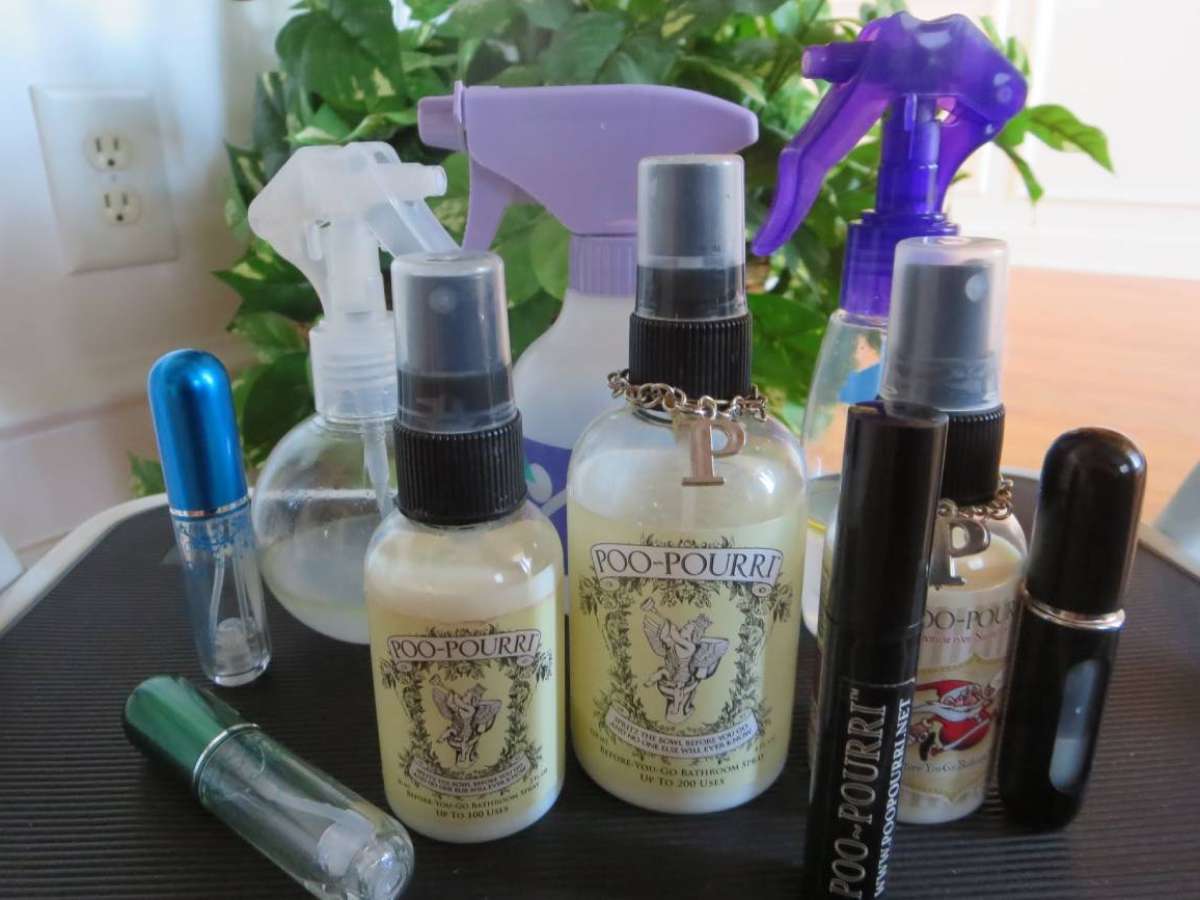Nothing is more annoying than seeing all of your hard work go to waste when an invasive species of insects starts eating away at your plants.
Fortunately, attracting beneficial insects to your garden is an easy (and natural!) way to prevent pesky garden bugs from destroying your plants.
I’m going to show you how to attract good bugs (like ladybugs) to your garden — and, specifically, what you should plant in your garden to attract the useful insects.
Beneficial Insects Are Better Than Chemicals
Some methods of garden pest control force you to harm the plants in your garden in the process of getting rid of the invasive species of insects.
Other methods are toxic in large doses to the environment over time — which can prevent the growth of any plants you put in the soil during future growing seasons.
However, if you focus solely on the invasive species of insects that is taking over your garden, then your efforts will have a better payoff.
One simple way to ensure that an invasive species of insects won’t stay long is to attract beneficial insects into your garden. This process relies on the natural order of the food chain within a garden.
For example, some insects prey on other insects. By attracting the predatory insects to your garden, lower food chain insects that can be more detrimental are killed off.
The pros of attracting beneficial insects to your garden:
- It doesn’t require the use of harmful chemicals.
- It allows you to grow plants that enhance the visual appeal of your garden.
Here’s how to do it…
How To Attract Good Bugs
#1 – The first step in attracting beneficial insects to your garden is more of a step of warning: be sure not to spray pesticides while using this method!
Pesticides cannot sort out the good from the bad — so using an insecticide will only hamper your results after planting flowers that attract the good bugs.
Ultimately, this method of garden pest control requires patience. Populations of insects (good and bad ones) may increase dramatically when first implementing this plan. However, after a short amount of time, the predator species will begin to kill off the invasive species.
You just need to allow time for the predatory insects to come to your garden and begin to reproduce. Rest assured, once they are in place and have sufficient nutrients, these predatory insects will be there to stay!
Natural predators aren’t a ‘silver bullet.’ Biological control affects a whole cycle of life over time. It’s a long term solution. Source
#2 – The next step is to choose which plants to utilize as attractors and decide how to place them in your garden.
Beneficial insects — like predatory beetles, ladybugs, nematodes, and mites — each want something different from a plant.
By planting various heights of plants, each of the insect species is satisfied.
For example, you’ll want to plant a short herb (such as thyme) to attract predatory beetles that can easily wipe out an invasion of aphids on leafy greens, and plant taller flowers (like daisies) to attract wasps and robber flies.
Here’s a list of beneficial predatory insects — the ones you want in your garden. (Here are more photos and details.)
This is a list of flowering plants (many are actually weeds) that provide nectar and pollen and serve well as attractor plants for beneficial insects:
- Alfalfa
- Arugula
- Baby Blue Eyes
- Baby’s Breath
- Barley
- Berseem Clover
- Bishops Flower
- Blanket Flower
- Bok Choi
- Broccoli
- Buckwheat
- Caraway
- Carrot
- Celery
- Cereal Ryegrass
- Common Knotweed
- Common Vetch
- Coneflowers
- Coreopsis
- Coriander
- Cosmos
- Crimson Clover
- Dill
- Fava Bean
- Fennel
- Goldenrod
- Hoary Alyssum
- Milkweeds
- Queen Anne’s Lace
- Radish
- Subclover
- Sunflower
- Sweet Alyssum
- Sweet Clover
- Tansy
- Wild Mustard
- Wild Parsnip
- Yarrow
- Yellow Rocket
Flowers provide pollen and nectar as a sort of bribe to induce insects to transfer pollen from one flower to the next and cause pollination. However, the size and shape of a flower limit the kinds of insects that can access its pollen and nectar. Many of the natural enemies that can benefit most from floral resources are very tiny wasps, which will get lost in a big flower. The best flowers for these small natural enemies are also small. Source
TIP: You can even plant a mixture of good bug seeds in your soil to attract beneficial garden insects!
#3 – Next, determine the right time of year to plant your attractor plants.
The earlier in the season the blooms begin, the earlier in the season you can stop worrying about infestations of pests destroying your plants.
Keep in mind, as each predator species of insects finds your garden of attractor plants, they will need other resources as well.
One obvious resource is water:
- Be sure to leave puddles of water in the garden for the beneficial insects to survive on.
- If your garden does not support puddles, place a saucer dish with a handful of rocks on top nearby — just make sure that it stays full at all times.
 #4 – One last thing you need to do when attracting beneficial insects is to make sure there is plenty of ground cover for them.
#4 – One last thing you need to do when attracting beneficial insects is to make sure there is plenty of ground cover for them.
Several predator species that will help with this natural method of insect pest control are nocturnal. During the day, they will need ample cover to protect themselves from the sun.
Here are some good examples:
- Moist mulch will attract predatory insects and help them find a permanent home in your garden.
- Stones with large surface areas and flat boards are also good reclusive spots for insects that will make them want to stay and keep eating away at the invasive pests.
I like to help people find unique ways to do things that will save time & money — so I write about “outside the box” Household Tips and Life Hacks that most wouldn’t think of. I’m super-organized. And I LOVE to clean! I even enjoy doing laundry (but not ironing). I’m also a lifelong dog owner — so I often share my favorite tips for living with dogs inside your home (like smart home design choices and dog-friendly cleaning & decorating ideas). Career-wise, I’ve been sharing my best ideas with others by blogging full-time since 1998 (the same year that Google started… and before the days of Facebook and YouTube). Prior to that, I worked in Higher Ed over 10 years before switching gears to pursue activities that I’m truly passionate about instead. For example, I’ve worked at a vet, in a photo lab, and at a zoo — to name a few. I enjoy the outdoors via bicycle, motorcycle, Jeep, or RV. When I’m not cleaning, organizing, decorating, or fixing something… you’ll find me at the corner of Good News & Fun Times as publisher of The Fun Times Guide (32 fun & helpful websites). To date, I’ve personally written over 200 articles about cleaning, organization, DIY repairs, and household hacks on this site! A few have over 2M shares; many others have over 100K shares.








